Concept.
A Concept?
Initially there was no concept. Instead, glattCAD Model Aircraft developed in 2005 out of the convic - tion from making better use of the daily rail travel time to and from work. This is how a series of high-quality 3D CAD designs for RC aircrafts and components have been created in the „Regional Express“ from Augsburg to Munich with the notebook on the lap. Permanently there are improve - ments, modifications and new projects going on. It was soon noticable that in the end of developing an RC model on the computer there would be a real airworthy prototype in turn to be tested, flown and improved. As a result, manuals, social media, a website, a CNC machine, expanded manufactu - ring possibilities and many things more had been demanded. The name changed from „glattCAD Flugmodelle“ to „glattCAD“ with the subtitels „Flugmodelle“ or „Model Aircraft“. This was due to the increasing interest in the work outside Germany.Project Choice.
The main focus in the selection of historical aircraft is mainly on types, which are rarely found on our model airfields and on the market. This means that modellers - and pilots (!) - who are interes - ted in the semi-scale and scale replica of historical aircraft models should feel addressed.Characteristics.
glattCAD RC Models with typical fuselage lengths or spans between 2 and 3 meters can be carried by car easily . Such dimensions can be handled with a manageable amount of effort from an assembling point of view, therefore they are perfectly suited for spontanious evening flights. Despite the high quality and exclusivity, glattCAD Model Aircraft are still affordable! With eight and fourteen serial lithium polymer cells, D.H. 88 Comet and Me-209 V1 are ideal for modern electric drives. Both can also be powered with combustion engines. Therefore special motor panels and components are available, too. For the Me-209 V1 assembly kits have also been specifically designed for the installation of the 2- and 3-cylinder in-line motors Kolm IL100V4 and Roto RM130FSI. The He-162 Salamander can be fired either by an electric ducted fan (EDF) or by a 120 .. 160 N jet engine.


CAM belongs to CAD.
Modern 3D CAD software enables the design of complex free-form shapes, half-timbered and geodetic structures. Parame - tric modeling can be used to create fantastic structures. Obviously there is a lot of work to do before feeding the CNC router with the components data!


Based
on
two-dimensional
three-
view
sketches,
cutaways,
blueprints
and
drawings
from
museums
as
well
as
on
many
photos
of
the
aircraft
pattern
and
its
details
(walk-
arounds),
the
computer
initially
crea
-
tes
a
precise
three-dimensional
free-
form
surface
model
of
the
aircraft
envelope.
Behind
this
is
a
mathema
-
tical
calculation
model
called
NURBS.
Starting
with
the
specified
require
-
ments
for
the
model´s
static
and
dynamic
flow-theoretical
parame
-
ters,
e.
g.
level-flight
speed,
landing
speed,
inherent
stability
(or
neutra
-
lity),

What
is
unusual
about
all
glattCAD
wooden
designs
is
the
aesthetics
of
the
structure,
which
is
unlikely
to
be
found
anywhere
else
on
the
versatile
RC
model
building
market
and
which
is
particularly
characteristic
of
glattCAD
Model
Aircraft:
The
combination
of
uncompromising
functionality
with
the
beauty of playful detail solutions.
RC
model
flight
brings
joy
to
us
-
this
is
a
self-evident
truth.
But
model
buil
-
ding
in
this
surprisingly
different
form
results
in
a
new
way
of
playing
our
passion!
"You were actually supposed to cover glattCAD Model Aircraft
with transparent foil only!"
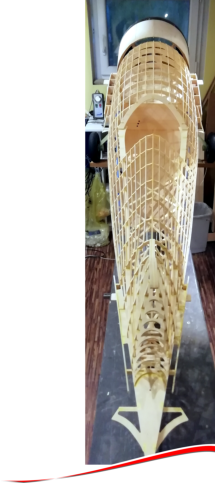




Flying Characteristics.
In addition to a good translation of dimensions and details of the original flying machine into the model, good flight cha - racteristics are at least as important. Using software-supported polars determination (wing and empennage airfoils) and vortex lattice analysis (airfoil distribu - tion over the model´s wingspan) calculations on the flight characteristics are made right at the start of CAD development. All model parameters like inherent stability/neutrality, various flight speeds and the flaps effects are concerned. The results are incorporated into the CAD design. Hence the mathematics of fluid mechanics and the model design are linked itera - tively. In this way, it is quite possible to equip models of historical aircraft with tame flight characteristics. Even if their man-car - rying originals are said to have bitches and peculiarities.Build Manuals.


D.H. 88 Comet
Me 209 V1

gearCONTROL.846
Manual
PC Application
V1.1.0
glattCAD Model
Aircraft Building is
Simple!
A look into the Comet´s, Heinkel´s or Messerschmitt´s build manuals reveal a variety of screenshots taken from the CAD development. The functions behind the components shown there cannot always be cat - ched immediately. So how long will it take to build such a complex RC model? Actually glattCAD Model Aircraft are easy to build!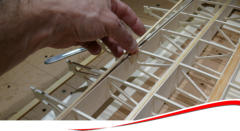
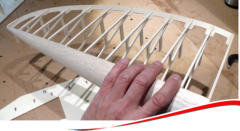
Puzzleing along a Build Manual.
The
"assembly"
is
more
like
a
puzzle,
in
which
each
piece
fits
into
the
other,
than
the
building
a
classical
Graupner
or
Robbe
model
kit
from
the
80s
or
90s.
But
in
contrast
to
a
vintage
puzzle
consis
-
ting
of
many
pieces,
where
long
searches
are
often
required
before
parts
finally
find
their
correct
places,
there
is
one
crucial
difference
with
glattCAD
Model
Aircraft:
The
comprehensive
illus
-
trated manual: a small masterpiece in itself.
The basic principles of the colorfully designed glattCAD build manuals are simple:
•
Less text, more illustration.
•
Split into seperate manageable steps.
•
Every part owns its number.
•
Parts still appearing coloured in one construction step will be shown grey in the next steps.


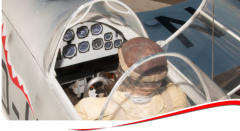

An Example…
… taken from the manual for the glattCAD Me-209 will explain this.


a
specific
software
program
calcula
-
tes
a
first
approximation
for
wing
airfoils,
airfoils
distribution,
angle-
difference
of
incidence
and
center
of
gravity.
These
results
flow
iteratively
back
into
the
envelope
surface
design
thus
starting
the
process
in
a
loop.
The
homogeneous
free-form
surfa
-
ces
created
in
this
way
serve
as
vir
-
tual
cutting
tools
for
the
develop
-
ment
of
fuselage
bulkheads
(frames),
wing
ribs,
tail
ribs,
spars,
a.s.o.
-
in
short:
all
components
in
contact
with
the
outer
shell
of
the
model.
The
later
thickness
of
the
plane's
balsa
covering
is
taken
into
account.
CAM
processes
follow.
Now
all
pla
-
nar
model
components
need
to
be
transfered
onto
flat
virtual
surfaces,
representing
the
computer
counter
-
parts
of
the
real
plywood
boards,
balsa
slats,
fiber
glass
or
carbon
sheets
to
be
milled.
The
CNC
prepa
-
ration
of
the
three-dimensional
assemblies,
i.e.
master
models
and
molds, is also pending.
Finally,
milling
paths,
speeds
and
other
strategies
for
the
CNC
machine
are
developed
and
optimi
-
zed.
The
machine
reliably
does
the
rest.
Nearly
any
sanding
of
parts
is
nee
-
ded
(apart
from
the
full
balsa
cover
-
ing).
Sanding
will
only
be
required
when
two
pieces
do
not
have
to
be
glued
together
in
right
angles
-
thanks
to
precisely
defined
dimensi
-
ons for all mortise & tenon parts.
Speaking
of
glueing:
It
is
almost
pos
-
sible
to
assemble
an
entire
fuselage
or
wing
on
its
jig
without
having
con
-
sumed
a
single
drop
of
glue
yet.
The
well-concieved
design
with
its
nume
-
rous
mortises
and
tenons
ensures
an
incomparable
stability
of
the
structure.
By
the
way,
the
auxilliary
jigs
on
which
fuselage,
wings,
horizontal
stabilizer
and
rudders
are
built
do
not
need
to
be
glued
or
screwed
to
the
construction
table.
You
can
freely
move
your
project
from
your
shop to any other place at any time.






The two parts R79 (left and right) are glued between the frames already mounted.
Parts R79 are now turned to grey. R33 (left and right) and R78 are glued in.
Again, the newly installed parts are now shown in grey. Five more formers are inserted into small martises in the jig.
By the way, no adhesive is required for this step.

© 2020-06 glattCAD Flugmodelle Christoph Glatt Bauernstr. 77 86462 Langweid am Lech
Info@glattCAD.de
He 162 Salamander
Fuselage
Empenn.
Wings





© 2020-06 glattCAD Flugmodelle Info@glattCAD.de
Christoph Glatt Bauernstr. 77 86462 Langweid am Lech

Concept.
A Concept?
Initially there was no concept. Ins - tead, glattCAD Model Aircraft developed in 2005 out of the con - viction from making better use of the daily rail travel time to and from work. This is how a series of high-quality 3D CAD designs for RC aircrafts and components have been created in the „Regional Express“ from Augsburg to Munich with the notebook on the lap. Permanently there are impro - vements, modifications and new projects going on. It was soon noticable that in t h e end of developing an RC model on the computer there would be a real airworthy prototype in turn to be tested, flown and improved. As a result, manuals, social media, a website, a CNC machine, expanded manufacturing possibilities and many things more had been demanded. The name changed from „glattCAD Flugmodelle“ to „glattCAD“ with the subti - tels „Flugmodelle“ or „Model Aircraft“. This was due to the increasing interest in the work outside Ger - many.Project Choice.
The main focus in the selection of historical aircraft is mainly on types, which are rarely found on our model airfields and on the market. This means that modellers - and pilots (!) - who are interested in the semi-scale and scale replica of historical aircraft models should feel addressed.Characteristics.
glattCAD RC Models with typical fuselage lengths or spans between 2 and 3 meters can be carried by car easily . Such dimensions can be handled with a manageable amount of effort from an assembling point of view, therefore they are perfectly suited for spontanious evening flights. Despite the high quality and exclusivity, glattCAD Model Aircraft are still affordable! With eight and fourteen serial lithium polymer cells, D.H. 88 Comet and Me-209 V1 are ideal for modern electric drives. Both can also be powered with combustion engines. Therefore special motor panels and components are available, too. For the Me-209 V1 assembly kits have also been specifically designed for the installation of the 2- and 3-cylinder in-line motors Kolm IL100V4 and Roto RM130FSI. The He-162 Salamander can be fired either by an electric ducted fan (EDF) or by a 120 .. 160 N jet engine.CAM belongs to CAD.
Modern 3D CAD software enables the design of complex free-form shapes, half-timbered and geo - detic structures. Parametric modeling can be used to create fantastic structures. Obviously there is a lot of work to do before feeding the CNC router with the components data!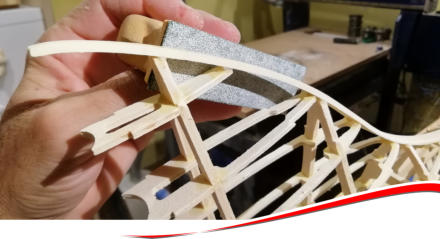
What
is
unusual
about
all
glattCAD
wooden
designs
is
the
aesthetics
of
the
structure,
which
is
unlikely
to
be
found
anywhere
else
on
the
versatile
RC
model
building
market
and
which
is
particularly
characteri
-
stic
of
glattCAD
Model
Aircraft:
The
combination
of
uncompromising
functionality
with
the
beauty
of
playful detail solutions.
RC
model
flight
brings
joy
to
us
-
this
is
a
self-evident
truth.
But
model
building
in
this
surprisingly
diffe
-
rent
form
results
in
a
new
way
of
playing
our
pas
-
sion!
"You were actually supposed
to cover glattCAD Model
Aircraft with transparent
foil only!"

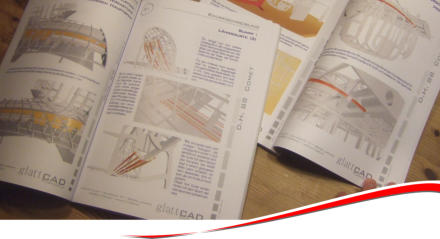
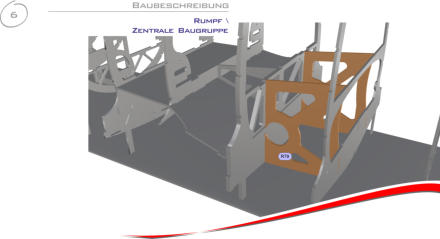
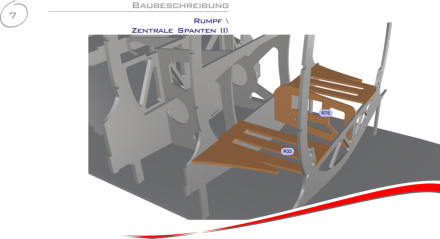
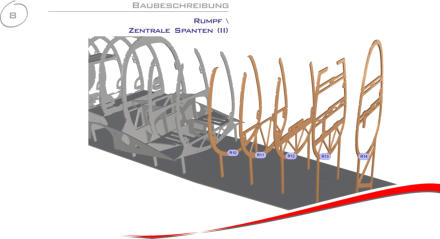
Flying Characteristics.
In addition to a good translation of dimensions and details of the original flying machine into the model, good flight characteristics are at least as important. Using software-supported polars determination (wing and empennage airfoils) and vortex lattice analysis (airfoil distribution over the model´s wing - span) calculations on the flight characteristics are made right at the start of CAD development. All model parameters like inherent stability/neutrality, various flight speeds and the flaps effects are con - cerned. The results are incorporated into the CAD design. Hence the mathematics of fluid mechanics and the model design are linked iteratively. In this way, it is quite possible to equip models of historical aircraft with tame flight characteristics. Even if their man-carrying originals are said to have bitches and peculiarities.Build Manuals.

D.H. 88 Comet
Me 209 V1

gearCONTROL.846
Manual
PC Application
V1.1.0
Puzzleing along a Build Manual.
The
"assembly"
is
more
like
a
puzzle,
in
which
each
piece
fits
into
the
other,
than
the
building
a
classical
Graupner
or
Robbe
model
kit
from
the
80s
or
90s.
But
in
contrast
to
a
vintage
puzzle
consisting
of
many
pieces,
where
long
searches
are
often
requi
-
red
before
parts
finally
find
their
correct
places,
there
is
one
crucial
difference
with
glattCAD
Model
Aircraft:
The
comprehensive
illustrated
manual:
a
small masterpiece in itself.
The basic principles of the colorfully designed glatt-
CAD build manuals are simple:
•
Less text, more illustration.
•
Split into seperate manageable steps.
•
Every part owns its number.
•
Parts still appearing coloured in one construc-
tion step will be shown grey in the next steps.

An Example…
… taken from the manual for the glattCAD Me-209 will explain this.
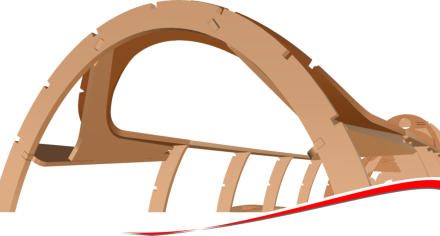
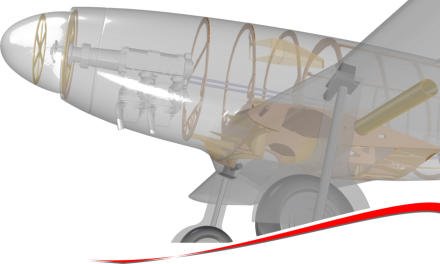
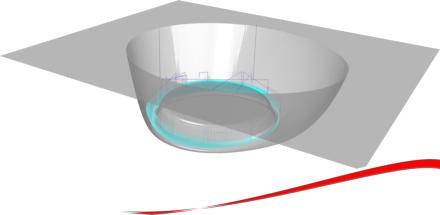
Based
on
two-dimensional
three-view
sketches,
cutaways,
blueprints
and
drawings
from
museums
as
well
as
on
many
photos
of
the
aircraft
pattern
and
its
details
(walk-arounds),
the
computer
initially
creates
a
precise
three-dimensional
free-form
sur
-
face
model
of
the
aircraft
envelope.
Behind
this
is
a
mathematical calculation model called NURBS.
Starting
with
the
specified
requirements
for
the
model´s
static
and
dynamic
flow-theoretical
para
-
meters,
e.
g.
level-flight
speed,
landing
speed,
inherent stability (or neutrality),
a
specific
software
program
calculates
a
first
appro
-
ximation
for
wing
airfoils,
airfoils
distribution,
angle-
difference
of
incidence
and
center
of
gravity.
These
results
flow
iteratively
back
into
the
envelope
sur
-
face design thus starting the process in a loop.
The
homogeneous
free-form
surfaces
created
in
this
way
serve
as
virtual
cutting
tools
for
the
deve
-
lopment
of
fuselage
bulkheads
(frames),
wing
ribs,
tail
ribs,
spars,
a.s.o.
-
in
short:
all
components
in
contact
with
the
outer
shell
of
the
model.
The
later
thickness
of
the
plane's
balsa
covering
is
taken
into
account.
CAM
processes
follow.
Now
all
planar
model
com
-
ponents
need
to
be
transfered
onto
flat
virtual
surfaces,
representing
the
computer
counterparts
of
the
real
plywood
boards,
balsa
slats,
fiber
glass
or
carbon
sheets
to
be
milled.
The
CNC
preparation
of
the
three-dimensional
assemblies,
i.e.
master
models and molds, is also pending.
Finally,
milling
paths,
speeds
and
other
strategies
for
the
CNC
machine
are
developed
and
optimized.
The
machine reliably does the rest.
glattCAD Model Aircraft
Building is Simple!
A look into the Comet´s, Heinkel´s or Messer - schmitt´s build manuals reveal a variety of screens - hots taken from the CAD development. The functions behind the components shown there can - not always be catched immediately. So how long will it take to build such a complex RC model? Actually glattCAD Model Aircraft are easy to build!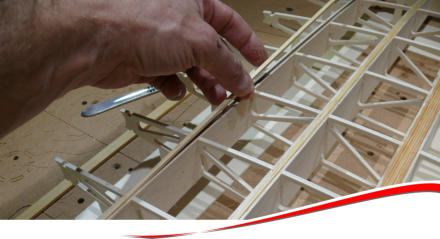
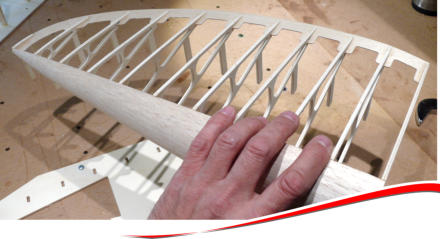
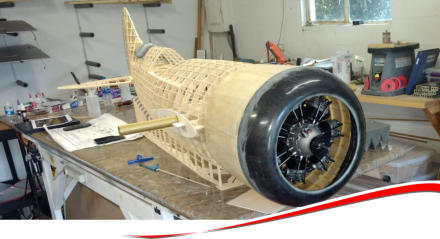
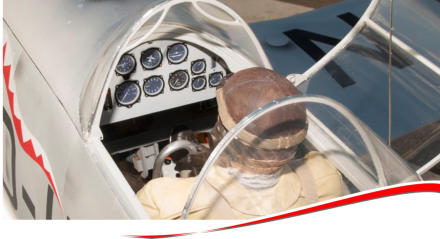
Nearly
any
sanding
of
parts
is
needed
(apart
from
the
full
balsa
covering).
Sanding
will
only
be
requi
-
red
when
two
pieces
do
not
have
to
be
glued
together
in
right
angles
-
thanks
to
precisely
defined
dimensions for all mortise & tenon parts.
Speaking
of
glueing:
It
is
almost
possible
to
assem
-
ble
an
entire
fuselage
or
wing
on
its
jig
without
having
consumed
a
single
drop
of
glue
yet.
The
well-
concieved
design
with
its
numerous
mortises
and
tenons
ensures
an
incomparable
stability
of
the
structure.
By
the
way,
the
auxilliary
jigs
on
which
fuselage,
wings,
horizontal
stabilizer
and
rudders
are
built
do
not
need
to
be
glued
or
screwed
to
the
construction
table.
You
can
freely
move
your
project
from
your
shop to any other place at any time.






The two parts R79 (left and right) are glued between the
frames already mounted.
Parts R79 are now turned to grey. R33 (left and right)
and R78 are glued in.
Again, the newly installed parts are now shown in grey.
Five more formers are inserted into small martises in
the jig.
By the way, no adhesive is required for this step.
He 162 Salamander
Fuselage
Empenn.
Wings













































